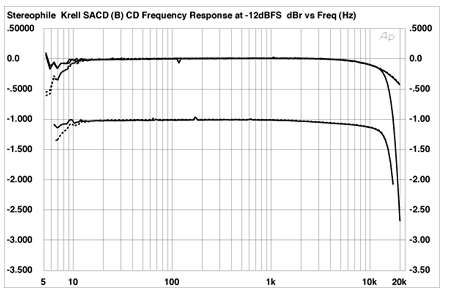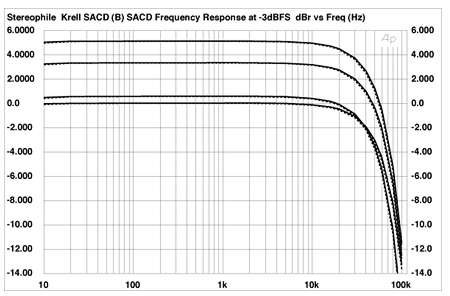| Columns Retired Columns & Blogs |
Krell SACD Standard multichannel SACD player Measurements
Sidebar 3: Measurements
As reviewed, the Krell's maximum output from its unbalanced outputs conformed to the CD standard at 1.97V RMS. This doubled, as expected, from the balanced L/R outputs. Neither set of outputs inverted absolute polarity, and the source impedance was 119 ohms unbalanced and 238 ohms balanced, both figures usefully low. Error correction for CD playback was excellent, the player coping with gaps in the data spiral up to 1mm in length without audible glitches.
The SACD Standard's channel separation (not shown) was superb, at 110dB in the R-L direction, 120dB in the other. Its frequency response for CD playback was the same from both outputs and was superbly flat up to the top octave, where it started to roll off a little early with Filter 1 (fig.1, top pair of traces), though not enough to be audible. Filter 2 gave a much steeper rolloff above 12kHz, reaching -3dB just above 20kHz (fig.1, middle traces). This tradeoff off in the frequency domain is to give better time-domain resolution, though the audible difference may be subtle. (Note that there is no passband level difference between these two filters for CD playback.) Pre-emphasized data gave a very similar response (fig.1, bottom traces), confirming that the small number of pre-emphasized CDs will play back correctly.

Fig.1 Krell SACD Standard, balanced outputs, CD frequency response at -12dBFS into 100k ohms, with de-emphasis (bottom) and without (top), the latter with Filter 1 (top) and Filter 2 (middle). (Right channel dashed, 0.5dB/vertical div.)
With SACD data, all the Krell's filter choices were basically flat within the audioband, differing only in the ultimate rolloff and gain. Filter 1 is specified as having the greatest ultrasonic bandwidth, but it still reaches its -3dB point at 50kHz (fig.2, bottom traces), which I believe is mandated by SACD licensors Sony and Philips. Filter 2 gave an overall gain of 0.5dB, but with a slightly faster ultrasonic rolloff (-3dB at 44kHz). Filters 3 and 4 featured gains of 5.15dB and 3.35dB, respectively (fig.2, top two pairs of traces), with, again, slightly different rolloff slopes (-3dB at 40kHz and 50kHz, respectively).

Fig.2 Krell SACD Standard, balanced outputs, SACD frequency response at -3dBFS into 100k ohms with (from bottom to top), Filters 1, 2, 4, and 3. (Right channel dashed, 1dB/vertical div.)
Fig.3 shows spectral analyses of the Krell player's output while it decoded dithered 16-bit (CD) data and DSD (SACD) data representing a 1kHz tone at -90dBFS, as well as DSD data representing a dithered 1kHz tone at -120dBFS. The Krell's noise floor is low—note the negligible level error on the -120dB tone—but the DSD encoding offers only about a bit's worth of resolution improvement over CD in the midrange and low treble while, as usual, the SACD actually has less resolution in the top audio octave (though by only a trivial amount). All the traces in the graph have a slight "bump" in the noise floor apparent at 200Hz, though this is probably irrelevant.

Fig.3 Krell SACD Standard, balanced, 1/3-octave spectrum of dithered 1kHz tone at -90dBFS, with noise and spuriae, 16-bit CD data (top) and DSD data (middle), with dithered 1kHz tone at -120dBFS, DSD data (bottom). (Right channel dashed.)
Linearity error for CD playback was very low down to below -110dBFS (fig.4), and is actually dominated by the recording's inherent dither noise. As noted above, the Krell's analog noise level is low, which, in conjunction with the excellent linearity, results in virtually perfect reproduction of an undithered 1kHz sinewave at -90.31dBFS, played back from CD (fig.5). The three discrete voltage levels can be clearly perceived, with excellent matching between the positive- and negative-going halves of the waveform.

Fig.4 Krell SACD Standard, balanced, right-channel departure from linearity, 16-bit CD data (2dB/vertical div.).

Fig.5 Krell SACD Standard, waveform of undithered 1kHz sinewave at -90.31dBFS, 16-bit CD data.
The Krell SACD Standard offered superbly low distortion, even into low impedances. Peculiarly, the spectrum of the distortion did differ slightly for CD and SACD playback: in the former, the third harmonic was highest in level (fig.6); in the latter, the second harmonic (fig.7). But, as can be seen from these graphs, the levels were so low that it is hard to see that they will have any subjective consequences.

Fig.6 Krell SACD Standard, unbalanced, spectrum of 1kHz sinewave, DC-1kHz, at 0dBFS into 8k ohms, CD data (linear frequency scale).

Fig.7 Krell SACD Standard, unbalanced, spectrum of 1kHz sinewave, DC-1kHz, at 0dBFS into 8k ohms, SACD data (linear frequency scale).
Intermodulation distortion was also extremely low (fig.8)—the 1kHz difference component resulting from an equal mix of 19kHz and 20kHz tones lies at -106dB (0.0005%)—though Filter 2's premature but slower rolloff seen in fig.1 is associated with a higher-than-usual amount of 24.1kHz component. Of more concern in this CD-derived graph is a shaping of the noise floor around the fundamental tones. As the nature of this shaping is signal-related, there will be a small degree of high-frequency noise modulation accompanying CD playback. Will this be audible? Certainly low-frequency noise modulation can be audible, but high-frequency effects might well be masked both by the music program and by the ear's decreasing sensitivity in this region.

Fig.8 Krell SACD Standard, unbalanced, HF intermodulation spectrum, DC-25kHz, 19+20kHz at 0dBFS into 8k ohms (linear frequency scale).
Measured using the Paul Miller Analyzer, the SACD Standard offered superbly low jitter from CD replay: just 197 picoseconds peak-peak. Data-related components in the player's analog output (fig.9, red numeric markers) were astonishingly low; in fact, the only significant sidebands present were at the low frequencies of 15Hz and its harmonics (purple numeric and circled markers).
But note again the shaping of the noise floor around the central, 11.025kHz tone. (Peculiarly, this shaping is the exact opposite of what I noticed in the measurements accompanying Paul Bolin's review, in August, of the excellent-sounding Esoteric DV-50 universal player.) The grayed-out trace in fig.9 shows a similar spectral analysis performed on the Krell's analog output while it decoded data representing an 11.025kHz tone on SACD. The data lacked the low-frequency squarewave, so the spectrum is free from data-related sidebands. But other than the high noise floor—due, I assume, to the DSD encoding's noiseshaping—the trace is free from jitter components (except for the ±15Hz sidebands).

Fig.9 Krell SACD Standard, unbalanced, high-resolution jitter spectrum of analog output signal (11.025kHz at -6dBFS sampled at 44.1kHz with LSB toggled at 229Hz). Center frequency of trace, 11.025kHz; frequency range, ±3.5kHz. (Grayed-out trace is SACD playback of 11.025kHz tone.)
Possible high-frequency, low-level noise modulation apart, the Krell SACD Standard offers superb measured performance.—John Atkinson
- Log in or register to post comments




































